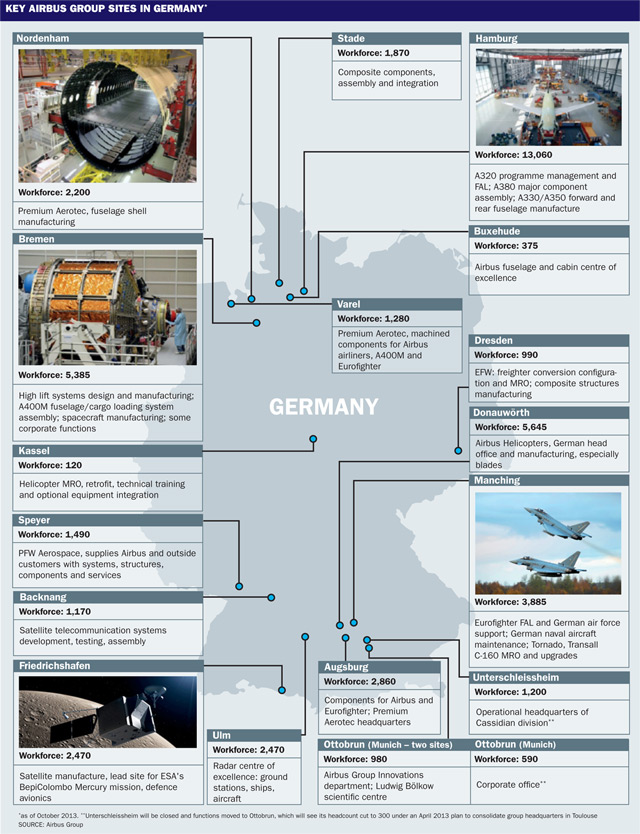Airbus, according to the company’s website, “will put the spotlight on innovation and its modern aircraft product line during a major presence at this year’s ILA Berlin Air Show, held in Germany – where the company has a significant industrial presence, highlighted by production sites across the country and the Hamburg-based A320 family final assembly line”.
Indeed, that industrial presence is also the driving force behind such high-profile machines as the Eurofighter Typhoon and A400M military transport – and spacecraft including Europe’s ATV robotic cargo ship. But one of the most important exhibits at ILA is Airbus – the corporation – itself.

Two years ago the company then known as EADS dropped a bomb during ILA by announcing its plan to merge with BAE Systems. That deal would have created the world’s biggest aerospace company, vastly expanded EADS’s weak defence business and given BAE a route to take some of its technology to the fast-growing civil market.
That proposal survived less than a month of public scrutiny. Investors were sceptical, with BAE shareholders openly questioning the merits of a merger they feared would undermine their company’s hard-earned position at the top table of US defence suppliers. But what killed the deal was a “no” from the German government – widely reported to have come personally from Chancellor Angela Merkel.
In retrospect, this failure was not surprising – however compelling to management the logic of the merger was. The French and German governments effectively controlled nearly half of EADS’s shares – an ownership and governance legacy of the group’s founding in 2000 by formally merging their national champion aerospace industries. London, meanwhile, had its own concerns over such a major change to its own national champion – which had been a third leg of the original EADS until it sold its stake to focus on its defence business, which was booming during the 2000s and the wars in Iraq and Afghanistan.
But the forces driving EADS boss Tom Enders and his BAE Systems counterpart Ian King did not wane just because their grand plan foundered. For Airbus particularly, those issues remain – even today – huge challenges. Part business and part political project, Airbus is saddled with many duplicated costs that no “normal” company would tolerate – and which leave it at a financial disadvantage when bidding for work against leaner, more nimble rivals.
Hamburg and Toulouse both host A320 and A380 final assembly lines, Ariane rocket components are built at multiple and multinational locations and Eurofighter Typhoons are assembled in four countries – including Italy, where Finmeccanica is a programme partner. Until 2007, EADS had co-chief executives (one French, one German) and – although this will end imminently – two headquarters in Toulouse and Munich.
So, the events of the nearly two years since Berlin quashed the scheme have been – if not strictly predictable – not surprising either. Plus, it is in Germany that the big questions remain, ironically.
With his merger plan grounded, Enders set about reinventing his company as a “normal” business – not the unwieldy state-private hybrid it had always been. First, he unveiled – and drove to fruition – a new governance deal. Agreed in December 2012, the new deal whittled the direct and proxy shareholdings of the French and German states down to 12% each, from 22.45%, while the Spanish government's holding was reduced to 4%, from 5.45%.
Critically, the deal eliminated the veto rights that Paris and Berlin had held over management decisions.
A year later, in December 2013, Enders moved to restructure the operating company, with the aim of closing its competitiveness gap. The four divisions of Airbus, Eurocopter, Astrium (space) and Cassidian (defence) are now three: Airbus, Airbus Helicopters, Airbus Defence & Space. The unloved acronym EADS (European Aeronautic Defence and Space) is also gone, in favour of Airbus Group.
Since then details have been under discussion with the unions, but the broad plan calls for 5,800 jobs to be cut – including 1,300 by allowing temporary contracts to lapse. Some 2,000 jobs will go in Germany, 1,260 in France, 557 in Spain, 450 in the UK and 180 in other countries. Up to 1,500 people may be absorbed by Airbus and Airbus Helicopters over the coming three years, but Enders expects the total to be more like 800-1,000. The number of compulsory layoffs is yet to be determined.
In Germany, a major site at Unterschleissheim near Munich will close, with its functions moved to Ottobrunn. The Paris corporate office at Montmorency will be sold and its functions moved to Suresnes, where the corporate technical office is already based.
Germany, clearly, will be taking a larger headcount hit in this restructuring than France. But then, Germany’s aerospace industry has done very well out of EADS/Airbus. Since the founding in 2000, the German workforce has expanded 44% to 50,100 employees as of October 2013. In France, growth has been just 19%, to 54,300.
The high-visibility change comes in Munich, which is losing its group headquarters status – although it will host the chief executive of the Defence & Space division, currently former Cassidian head Bernhard Gerwert. Enders – a German – has already consolidated corporate leadership in Toulouse.
The interesting question now is how sensitive Germans are to that loss. If Enders’ plan succeeds in bolstering group fortunes – particularly for the defence and space businesses – the answer may be “not very”. But whatever comes next, it will be months if not years before the full ramifications of this restructuring are evident.
Source: FlightGlobal.com

















